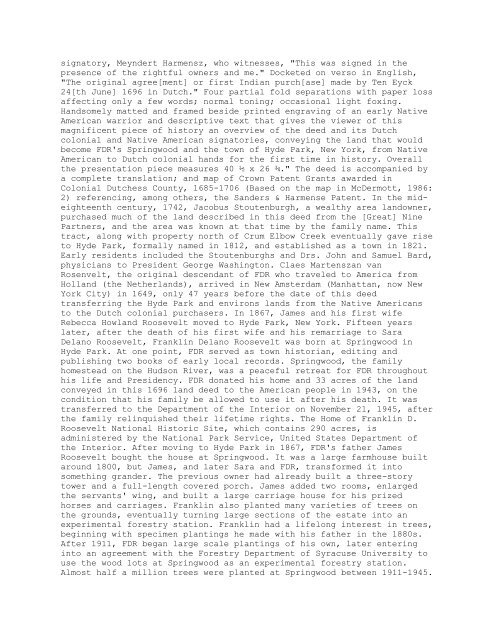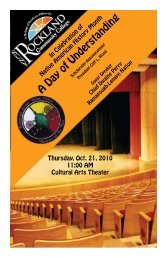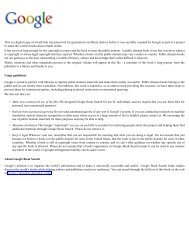Native American 1696 Land Deed for Most of Hyde Park, New York
Native American 1696 Land Deed for Most of Hyde Park, New York
Native American 1696 Land Deed for Most of Hyde Park, New York
Create successful ePaper yourself
Turn your PDF publications into a flip-book with our unique Google optimized e-Paper software.
signatory, Meyndert Harmensz, who witnesses, "This was signed in the<br />
presence <strong>of</strong> the rightful owners and me." Docketed on verso in English,<br />
"The original agree[ment] or first Indian purch[ase] made by Ten Eyck<br />
24[th June] <strong>1696</strong> in Dutch." Four partial fold separations with paper loss<br />
affecting only a few words; normal toning; occasional light foxing.<br />
Handsomely matted and framed beside printed engraving <strong>of</strong> an early <strong>Native</strong><br />
<strong>American</strong> warrior and descriptive text that gives the viewer <strong>of</strong> this<br />
magnificent piece <strong>of</strong> history an overview <strong>of</strong> the deed and its Dutch<br />
colonial and <strong>Native</strong> <strong>American</strong> signatories, conveying the land that would<br />
become FDR's Springwood and the town <strong>of</strong> <strong>Hyde</strong> <strong>Park</strong>, <strong>New</strong> <strong>York</strong>, from <strong>Native</strong><br />
<strong>American</strong> to Dutch colonial hands <strong>for</strong> the first time in history. Overall<br />
the presentation piece measures 40 ½ x 26 ¾." The deed is accompanied by<br />
a complete translation; and map <strong>of</strong> Crown Patent Grants awarded in<br />
Colonial Dutchess County, 1685-1706 (Based on the map in McDermott, 1986:<br />
2) referencing, among others, the Sanders & Harmense Patent. In the mideighteenth<br />
century, 1742, Jacobus Stoutenburgh, a wealthy area landowner,<br />
purchased much <strong>of</strong> the land described in this deed from the [Great] Nine<br />
Partners, and the area was known at that time by the family name. This<br />
tract, along with property north <strong>of</strong> Crum Elbow Creek eventually gave rise<br />
to <strong>Hyde</strong> <strong>Park</strong>, <strong>for</strong>mally named in 1812, and established as a town in 1821.<br />
Early residents included the Stoutenburghs and Drs. John and Samuel Bard,<br />
physicians to President George Washington. Claes Martenszan van<br />
Rosenvelt, the original descendant <strong>of</strong> FDR who traveled to America from<br />
Holland (the Netherlands), arrived in <strong>New</strong> Amsterdam (Manhattan, now <strong>New</strong><br />
<strong>York</strong> City) in 1649, only 47 years be<strong>for</strong>e the date <strong>of</strong> this deed<br />
transferring the <strong>Hyde</strong> <strong>Park</strong> and environs lands from the <strong>Native</strong> <strong>American</strong>s<br />
to the Dutch colonial purchasers. In 1867, James and his first wife<br />
Rebecca Howland Roosevelt moved to <strong>Hyde</strong> <strong>Park</strong>, <strong>New</strong> <strong>York</strong>. Fifteen years<br />
later, after the death <strong>of</strong> his first wife and his remarriage to Sara<br />
Delano Roosevelt, Franklin Delano Roosevelt was born at Springwood in<br />
<strong>Hyde</strong> <strong>Park</strong>. At one point, FDR served as town historian, editing and<br />
publishing two books <strong>of</strong> early local records. Springwood, the family<br />
homestead on the Hudson River, was a peaceful retreat <strong>for</strong> FDR throughout<br />
his life and Presidency. FDR donated his home and 33 acres <strong>of</strong> the land<br />
conveyed in this <strong>1696</strong> land deed to the <strong>American</strong> people in 1943, on the<br />
condition that his family be allowed to use it after his death. It was<br />
transferred to the Department <strong>of</strong> the Interior on November 21, 1945, after<br />
the family relinquished their lifetime rights. The Home <strong>of</strong> Franklin D.<br />
Roosevelt National Historic Site, which contains 290 acres, is<br />
administered by the National <strong>Park</strong> Service, United States Department <strong>of</strong><br />
the Interior. After moving to <strong>Hyde</strong> <strong>Park</strong> in 1867, FDR's father James<br />
Roosevelt bought the house at Springwood. It was a large farmhouse built<br />
around 1800, but James, and later Sara and FDR, trans<strong>for</strong>med it into<br />
something grander. The previous owner had already built a three-story<br />
tower and a full-length covered porch. James added two rooms, enlarged<br />
the servants' wing, and built a large carriage house <strong>for</strong> his prized<br />
horses and carriages. Franklin also planted many varieties <strong>of</strong> trees on<br />
the grounds, eventually turning large sections <strong>of</strong> the estate into an<br />
experimental <strong>for</strong>estry station. Franklin had a lifelong interest in trees,<br />
beginning with specimen plantings he made with his father in the 1880s.<br />
After 1911, FDR began large scale plantings <strong>of</strong> his own, later entering<br />
into an agreement with the Forestry Department <strong>of</strong> Syracuse University to<br />
use the wood lots at Springwood as an experimental <strong>for</strong>estry station.<br />
Almost half a million trees were planted at Springwood between 1911-1945.





